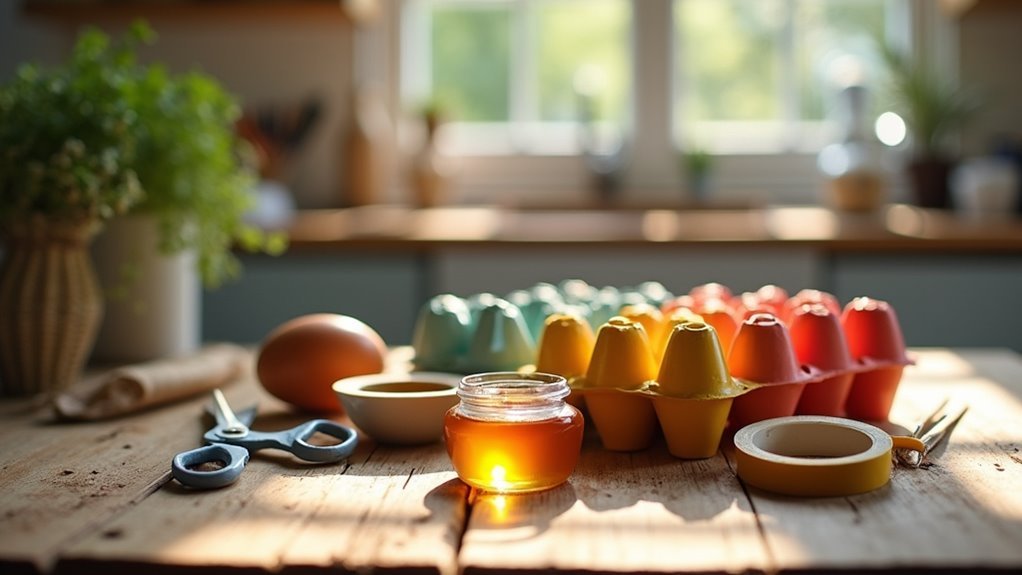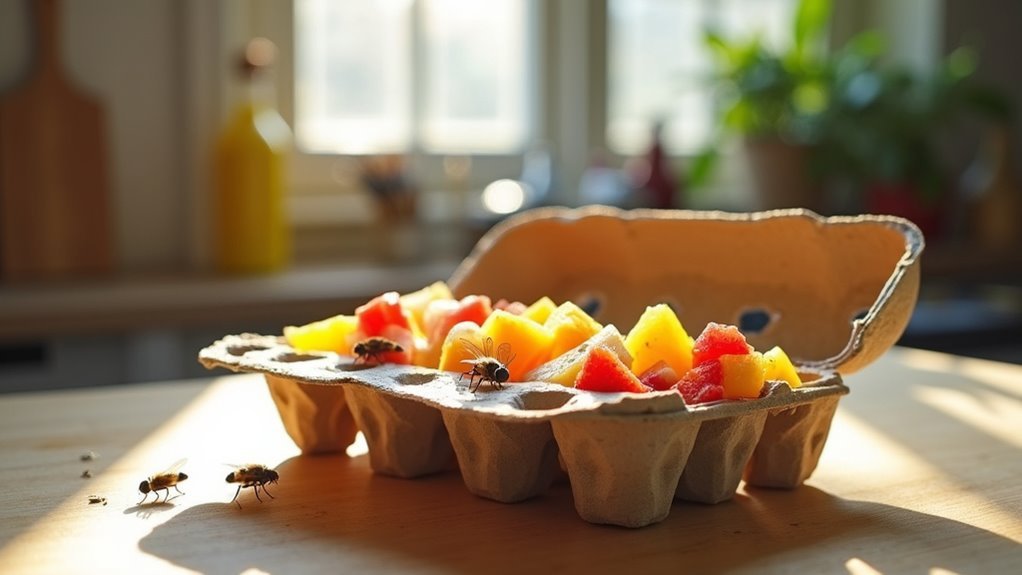You’ll need a clean cardboard egg carton, scissors, and sweet attractants like honey or karo syrup. Cut the carton horizontally into halves, then punch small entry holes in each cup’s bottom. Mix equal parts sugar and water with a few drops of dish soap to break surface tension. Pour this bait mixture into the bottom compartments and place your traps near high-activity areas like garbage cans. Follow these complete steps for maximum effectiveness.
Materials Needed for Your Egg Carton Fly Trap

Creating an effective egg carton fly trap starts with gathering a few simple household items you likely already have on hand.
You’ll need a recycled egg carton as your trap’s main structure. For bait materials, collect sweet attractants like karo syrup or honey that’ll draw flies through their irresistible sweetness.
Grab scissors to cut the egg carton into halves or individual cups, creating multiple trapping surfaces. You’ll also need hot melt glue or tape to secure components and enhance your trap’s durability.
Finally, place a frying pan underneath to catch spills and contain the setup, ensuring cleaner monitoring fly activity.
These basic materials will create an efficient, cost-effective fly control solution.
Preparing the Egg Carton Base
You’ll want to start with a clean, dry cardboard egg carton rather than foam since cardboard holds bait better and won’t repel flies.
Cut the carton directly down the middle using sharp scissors to create two separate trap bases, each containing six egg cups.
Punch small entry holes in the bottom of each cup using a nail or awl – make them just large enough for flies to crawl through but small enough to keep your bait from falling out.
Selecting Right Carton Type
Since the foundation of your fly trap determines its overall effectiveness, selecting the right egg carton type becomes essential for success. You’ll want to choose a standard cardboard egg carton because it’s lightweight and easy to manipulate during construction. Confirm your chosen carton is clean and dry to prevent contamination that might repel flies.
| Carton Type | Material | Recommendation |
|---|---|---|
| Cardboard Standard | Recyclable fiber | Best choice |
| Cardboard with Lid | Recyclable fiber | Excellent option |
| Plastic Standard | Polystyrene | Avoid |
Opt for a dozen-egg carton to maximize your trapping capacity, as the larger surface area accommodates more bait. Cartons with lid features work exceptionally well since they help contain the bait while enhancing overall trap effectiveness.
Cutting Carton in Half
The cutting process transforms your selected egg carton into a functional trap base that’ll serve as the foundation for catching flies.
Start by placing your clean, dry egg carton on a stable surface where you can work comfortably. Take sharp scissors and carefully cut the carton horizontally through the middle, creating two equal halves.
You’ll need to cut through each divider section between the egg compartments to guarantee complete separation. This creates distinct trap bases that’ll effectively contain flies once your homemade device is operational.
After cutting, inspect both halves for rough or jagged edges that could cause injury. Trim any uneven spots with your scissors.
Keep one half for your current trap project and either dispose of the other half responsibly or save it for future DIY endeavors.
Creating Entry Holes
After securing your prepared carton half, it’s time to create strategically placed entry holes that’ll lure flies into your trap while preventing their escape.
You’ll need a sharp knife or scissors to punch small openings on the top surface of your egg carton. Make these holes large enough for flies to enter but small enough to prevent easy escape.
- Space holes 1-2 inches apart across the carton’s surface
- Position entry holes near the center for maximum accessibility
- Keep hole size ideal – big enough to attract flies, small enough to trap them
- Maintain the carton’s structural integrity while creating multiple access points
This strategic approach to creating entry holes transforms your ordinary egg carton into an effective trap that’ll successfully capture unwanted flying pests.
Creating the Bait Mixture
You’ll need to create an effective bait mixture that draws flies into your trap.
Start by combining equal parts sugar and water to form a sweet syrup base that naturally attracts these pests.
Next, add a few drops of dish soap to the mixture, which breaks the surface tension and prevents trapped flies from escaping once they land in the liquid.
Sweet Syrup Base
Creating an irresistible bait mixture starts with combining 1/4 cup of syrup—whether you choose karo syrup or honey—with 1 tablespoon of water to achieve the perfect consistency for spreading.
This sweet syrup base forms the foundation of your fly trap’s success. You’ll want to spread this mixture evenly across your cardboard pieces to maximize trapping surface area.
To make your bait even more effective, add a few drops of apple cider vinegar for extra scent appeal that’ll attract flies from greater distances.
- Mix in one teaspoon of brown sugar to increase sweetness and attract diverse fly species
- Guarantee even distribution across all cardboard surfaces for maximum coverage
- Add apple cider vinegar drops to enhance the bait’s attractive properties
- Replace the mixture when it’s full of flies or becomes dried out
Adding Soap Component
While your sweet syrup base provides the initial attraction, incorporating a few drops of dish soap into the mixture creates the essential trapping mechanism that prevents flies from escaping. The soap breaks the surface tension of your homemade bait, ensuring that once flies land on the sticky mixture, they can’t lift off again.
This simple addition transforms your basic syrup into an effective trap that holds insects securely.
Add just three to four drops of dish soap to your syrup and water combination. You don’t need much – too much soap can overpower the sweet scent that draws flies in initially.
Mix all components thoroughly until you achieve a uniform consistency throughout the entire bait mixture, creating the perfect balance for your trap.
Assembling the Trap Components

Start by cutting your egg carton in half lengthwise, creating two separate bowl-shaped sections that’ll serve as the foundation for your fly traps. This Easy Homemade approach gives you multiple traps from one carton, maximizing your trap DIY efficiency.
Next, you’ll assemble the components by securing any loose parts. Use strong tape or glue to reinforce corners and edges, guaranteeing your traps won’t fall apart during use. The structure must be sturdy enough to hold your bait mixture effectively.
- Cut egg cartons lengthwise to create bowl-shaped trap bases
- Secure all loose sections with tape or strong adhesive
- Add your prepared bait mixture to the bottom compartments
- Test stability before deploying to guarantee proper functionality
Pour your syrup or vinegar bait into each compartment, and your traps are ready for deployment.
Optimal Placement and Positioning
Once you’ve assembled your egg carton fly traps, strategic placement becomes essential for maximum effectiveness. Position your traps near high-activity areas like garbage cans, fruit bowls, or compost bins where flies congregate most. This ideal placement guarantees your fruit fly traps attract the maximum number of pests.
Avoid direct sunlight, which dries out bait quickly and reduces trap appeal. Elevate traps slightly above surfaces to prevent spills while allowing easy fly access.
You’ll find these DIY methods work best when you deploy multiple traps across different locations, covering wider infestation areas.
Monitor your traps regularly and don’t hesitate to reposition them if fly activity shifts. Effective trap management means adapting placement based on where you observe the most fly movement in your space.
Maintenance and Monitoring Tips

After deploying your egg carton fly traps, consistent maintenance guarantees they’ll continue catching flies effectively.
Regular monitoring every few days helps you assess performance and determine when bait replacement is necessary. Count the trapped flies to gauge your trap’s success rate and make adjustments accordingly.
Key Maintenance Tasks:
- Check bait freshness – Replace spoiled bait every 3-4 days to maintain ideal attraction
- Monitor catch numbers – Track flies caught to evaluate effectiveness and adjust placement if needed
- Dispose properly – Seal filled traps in plastic bags to prevent escape and control odors
- Clean surrounding areas – Remove spilled bait and debris that might attract additional flies
Consider rotating trap locations periodically to target different fly activity zones, maximizing your pest control efforts throughout your space.
Disposal and Replacement Guidelines
Beyond regular maintenance, knowing how to properly dispose of your egg carton fly traps prevents potential health hazards and maintains a clean environment.
When traps become full or after a few days of use, seal them completely in plastic bags before disposal. This prevents any remaining flies from escaping and causing new infestations throughout your home.
Always seal used fly traps in plastic bags before throwing them away to prevent flies from escaping and reinfesting your home.
After removing old traps, clean any residual syrup or attractants from the area thoroughly. This step’s essential because leftover bait can continue attracting flies even after you’ve removed the traps.
Replace your traps every few days to maintain peak effectiveness against fly populations.
Store unused egg cartons in dry locations to prevent moisture and mold.
Consider creating multiple traps simultaneously, replacing them as needed based on your home’s fly activity levels.
Frequently Asked Questions
What Is the Best Homemade Trap for Flies?
You’ll find the best homemade fly trap uses sweet bait like syrup or honey on a sticky cardboard surface. Mix vinegar with sugar for better attraction, and regularly replace the bait to maintain effectiveness.
Does Vinegar and Dawn Get Rid of Flies?
Yes, vinegar and Dawn effectively eliminate flies. You’ll attract them with apple cider vinegar’s fermentation scent, while Dawn breaks surface tension, trapping flies so they can’t escape and drown in the mixture.
What Liquid Attracts Flies the Most?
You’ll find apple cider vinegar attracts flies most effectively, especially fruit flies. Its fermented scent mimics rotting fruit they’re naturally drawn to. Sweet liquids like honey and syrup also work well for trapping flies.
What Are the Three Ingredients in Fly Trap?
You’ll need three main ingredients for your fly trap: a sweet bait like syrup or vinegar to attract flies, a container to hold everything, and a trapping mechanism that prevents their escape.
In Summary
You’ve now got an effective, budget-friendly fly trap that’ll keep your space pest-free. Remember to check it daily and refresh the bait when it loses its potency. Don’t forget to position multiple traps around problem areas for maximum coverage. With regular maintenance, your homemade egg carton fly trap will provide weeks of reliable pest control. It’s an eco-friendly solution that transforms waste into a practical household tool.





Leave a Reply